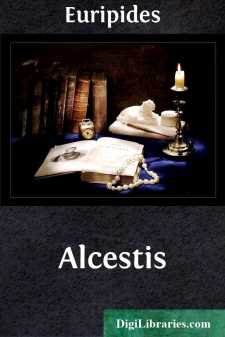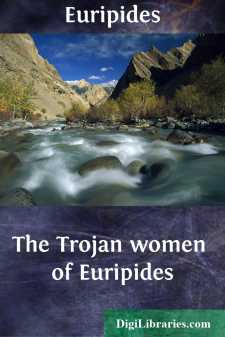Categories
- Antiques & Collectibles 13
- Architecture 36
- Art 48
- Bibles 22
- Biography & Autobiography 813
- Body, Mind & Spirit 142
- Business & Economics 28
- Children's Books 16
- Children's Fiction 13
- Computers 4
- Cooking 94
- Crafts & Hobbies 4
- Drama 346
- Education 46
- Family & Relationships 57
- Fiction 11829
- Games 19
- Gardening 17
- Health & Fitness 34
- History 1377
- House & Home 1
- Humor 147
- Juvenile Fiction 1873
- Juvenile Nonfiction 202
- Language Arts & Disciplines 88
- Law 16
- Literary Collections 686
- Literary Criticism 179
- Mathematics 13
- Medical 41
- Music 40
- Nature 179
- Non-Classifiable 1768
- Performing Arts 7
- Periodicals 1453
- Philosophy 64
- Photography 2
- Poetry 896
- Political Science 203
- Psychology 42
- Reference 154
- Religion 513
- Science 126
- Self-Help 84
- Social Science 81
- Sports & Recreation 34
- Study Aids 3
- Technology & Engineering 59
- Transportation 23
- Travel 463
- True Crime 29
The Iphigenia in Tauris of Euripides
by: Euripides
Description:
Excerpt
The Iphigenia in Tauris is not in the modern sense a tragedy; it is a romantic play, beginning in a tragic atmosphere and moving through perils and escapes to a happy end. To the archaeologist the cause of this lies in the ritual on which the play is based. All Greek tragedies that we know have as their nucleus something which the Greeks called an Aition—a cause or origin. They all explain some ritual or observance or commemorate some great event. Nearly all, as a matter of fact, have for this Aition a Tomb Ritual, as, for instance, the Hippolytus has the worship paid by the Trozenian Maidens at that hero's grave. The use of this Tomb Ritual may well explain both the intense shadow of death that normally hangs over the Greek tragedies, and also perhaps the feeling of the Fatality, which is, rightly or wrongly, supposed to be prominent in them. For if you are actually engaged in commemorating your hero's funeral, it follows that all through the story, however bright his prospects may seem, you feel that he is bound to die; he cannot escape. A good many tragedies, however, are built not on Tomb Rituals but on other sacred Aitia: on the foundation of a city, like the Aetnae, the ritual of the torch- race, like the Prometheus; on some great legendary succouring of the oppressed, like the Suppliant Women of Aeschylus and Euripides. And the rite on which the Iphigenia is based is essentially one in which a man is brought to the verge of death but just does not die.
The rite is explained in 11. 1450 ff. of the play. On a certain festival at Halae in Attica a human victim was led to the altar of Artemis Tauropolos, touched on the throat with a sword and then set free: very much what happened to Orestes among the Tauri, and exactly what happened to Iphigenia at Aulis. Both legends have doubtless grown out of the same ritual.
Like all the great Greek legends, the Iphigenia myths take many varying forms. They are all of them, in their essence, conjectural restorations, by poets or other 'wise men,' of supposed early history. According to the present play, Agamemnon, when just about to sail with all the powers of Greece against Troy, was bound by weather at Aulis. The medicine-man Calchas explained that Artemis demanded the sacrifice of his daughter, Iphigenia, who was then at home with her mother, Clytemnestra. Odysseus and Agamemnon sent for the maiden on the pretext that she was to be married to the famous young hero, Achilles; she was brought to Aulis and treacherously slaughtered—or, at least, so people thought.
There is a subject for tragedy there; and it was brilliantly treated in Euripides' Iphigenia in Aulis, which was probably left unfinished at his death. But our play chooses a later moment of the story.
In reality Artemis at the last moment saved Iphigenia, rapt her away from mortal eyes and set her down in the land of the Tauri to be her priestess. (In Tauris is only the Latin for "among the Tauri.") These Tauri possessed an image of Artemis which had fallen from heaven, and kept up a savage rite of sacrificing to it all strangers who were cast on their shores. Iphigenia, obedient to her goddess, and held by "the spell of the altar," had to consecrate the victims as they went in to be slain. So far only barbarian strangers had come: she waited half in horror, half in a rage of revenge, for the day when she should have to sacrifice a Greek. The first Greek that came was her own brother, Orestes, who had been sent by Apollo to take the image of Artemis and bear it to Attica, where it should no more be stained with human sacrifice.
If we try to turn from these myths to the historical facts that underlay them, we may conjecture that there were three goddesses of the common Aegean type, worshipped in different places. At Brauron and elsewhere there was Iphigenia ('Birth-mighty'); at Halae there was the Tauropolos ('the Bull-rider,' like Europa, who rode on the horned Moon); among the savage and scarcely known Tauri there was some goddess to whom shipwrecked strangers were sacrificed. Lastly there came in the Olympian Artemis. Now all these goddesses (except possibly the Taurian, of whom we know little) were associated with the Moon and with child-birth, and with rites for sacrificing or redeeming the first-born. Naturally enough, therefore, they were all gradually absorbed by the prevailing worship of Artemis. Tauropolis became an epithet of Artemis, Iphigenia became her priestess and 'Keybearer.' And the word 'Tauropolis,' which had become obscure, was explained as a reference to the Tauri....







